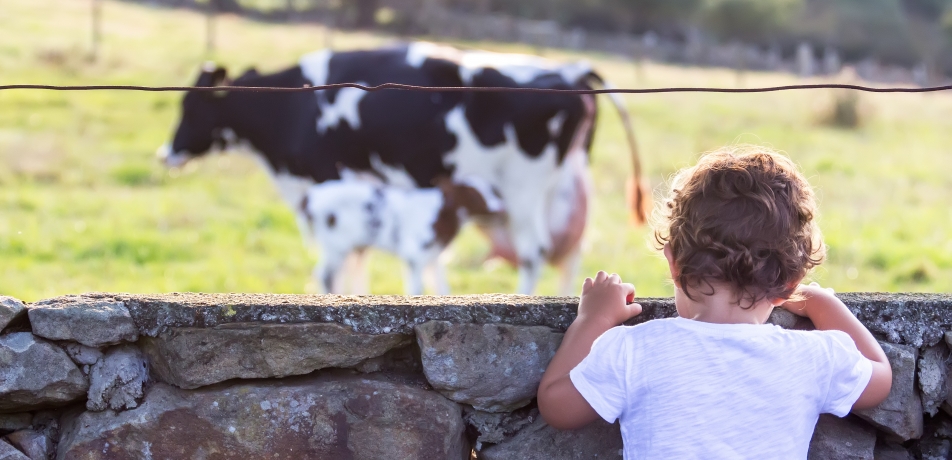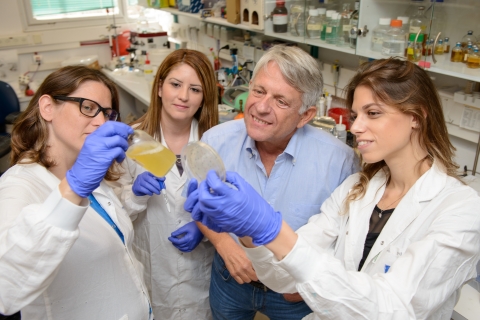Grass roots discovery
The gut bacteria that humans and cows share
Briefs

Grass roots discovery
Humans and cows may have vastly different diets, but how different is the way each species digests its food? Well, it’s not as black-and-white as you might think.
New research by the Weizmann Institute’s Prof. Ed Bayer has revealed that humans and cows share a common type of bacterium living in our respective digestive systems. A protein complex called a cellulosome sits on the surface of this type of bacterial cell and its job is to break down the tough cellulose in plants. He went on to suggest that the activities of the cellulosome may have implications for human health including obesity, metabolic syndrome, and diabetes.
Prof. Bayer, of the Department of Biomolecular Sciences, and his colleague at Tel Aviv University, Prof. Raphael Lamed, discovered the cellulosome in 1983 on a bacterium that naturally breaks down the cellulose in organic matter such as decaying wood and other plants. Their research over the years has shown that the cellulosome is recognizable by its unique, Lego-like assembly of proteins, including a string of backbone proteins and a series of attachable enzyme units. These chop up the long, indigestible sugar chains in cellulose into simple sugars that other bacteria can then consume.
The latest discovery emerged from the grass roots—two scientists swapping ideas about their respective research, after Prof. Bayer heard Prof. Harry Flint of the UK's University of Aberdeen describe a component of a bacterium in the cow rumen (a part of its digestive track). Prof. Bayer recognized in the description the components of a cellulosome. Thus began a collaboration to study the structure and function of this machinery in an animal’s digestive system.
The bacteria in a cow’s rumen are the main agents of digestion, breaking down into shorter bits the cellulose and other long polysaccharide molecules in hay and grass. The group’s research showed that the cellulosomes on these bacteria are built on the same basic plan as those in the wood-eating bacteria, with attachable enzymes that are adapted to breaking down the cellulose in grasses.
A growing body of research shows that humans, too, rely on the activities of the populations of bacteria in our intestinal tracts—collectively referred to as the microbiome. Our microbiomes have now been found to affect everything from our weight to our metabolic and immune system functions. Prof. Bayer and his colleagues managed to find cellulosomes in bacteria that live in the human large intestine. When a French team published the genome of a human intestinal bacterium that appeared to be similar to the cow bacterium, Prof. Bayer said, “We sensed that the similarities were in the cellulosome-like elements.”
A team from France, the U.S., the U.K., and Prof. Bayer’s lab in Israel went to work on the genetic sequence of this bacterium, and reached the verdict that these particular human gut bacteria carry cellulosomes.
Since we don’t normally live off grass or hay, why do we have these bacteria in common with cows? Prof. Bayer thinks they may have a protective function: preventing damage to the soft tissue of our digestive tract from the abrasive cellulose fibers we ingest in our fruit and vegetables. Just how much influence the cellulosome has on other metabolic conditions is the subject of his future research.
Prof. Ed Bayer's research is supported by the Dana and Yossie Hollander Center for Structural Proteomics; the Leona M. and Harry B. Helmsley Charitable Trust; and the Jewish Community Endowment Fund. Prof. Bayer is the incumbent of the Maynard I. and Elaine Wishner Professorial Chair of Bio-Organic Chemistry.

Prof. Bayer with members of his team







